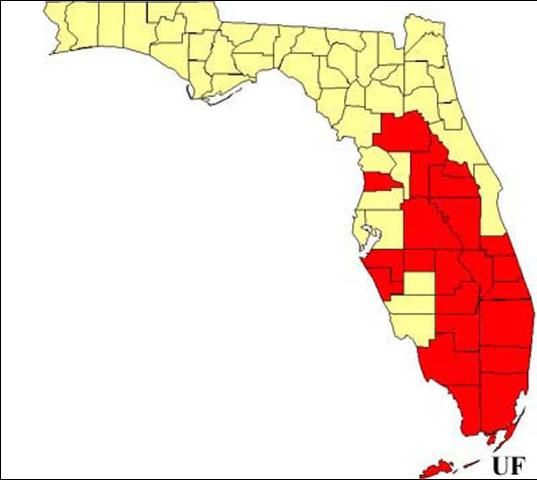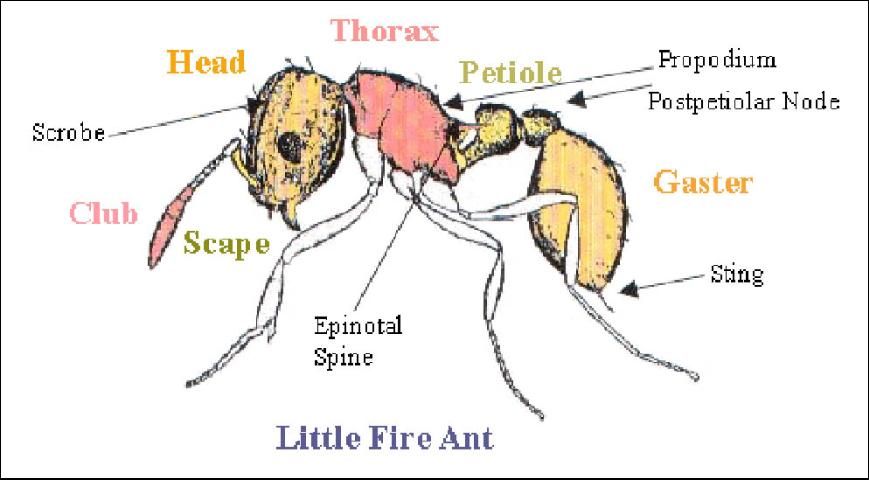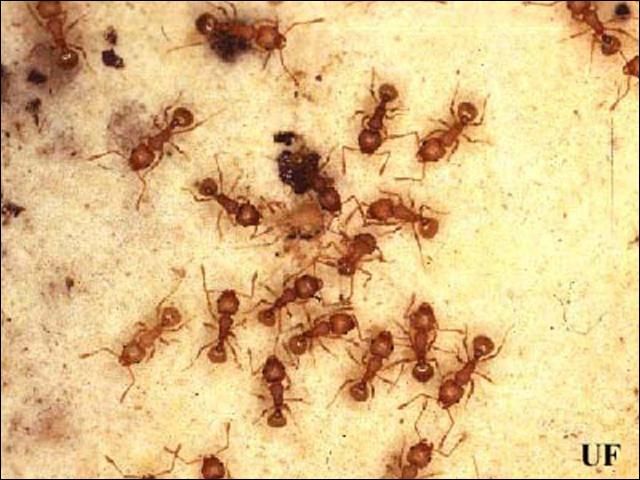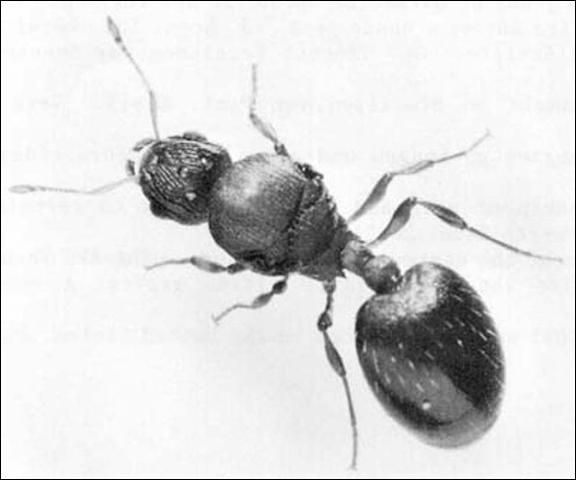The Featured Creatures collection provides in-depth profiles of insects, nematodes, arachnids and other organisms relevant to Florida. These profiles are intended for the use of interested laypersons with some knowledge of biology as well as academic audiences.
Introduction
Prior to the advent of chlorinated hydrocarbons, organophosphates, and carbamates the little fire ant, Wasmannia auropunctata (Roger), was a problem in Florida. The use of these persistent pesticide chemicals reduced the populations of the ants until they were no longer a menace. In the absence of these persistent pesticide chemicals populations of little fire ants increase, and in some areas, may develop into a serious problem.
Taxonomy
Wasmannia auropunctata was originally described by Roger (1863) as Tetramorium auropunctata from specimens collected in Cuba. Forel (1893) described the genus Wasmannia. Enzmann (1947) described Hercynia panamana as a new genus and species from Panama. Brown (1948) relegated Hercynia panamana to synonymy, as the type specimens were identical to auropunctata.
Distribution
The little fire ant is a common tramp ant species located throughout northern and central South America, the West Indies, the warmer portions of Mexico and the southeastern United States. This species is also found in the Galapagos Islands, West Africa (Gabon, Cameroon, and possibly the Republic of Congo and the Democratic Republic of Congo), Melanesia (New Caledonia, Solomon Islands, and Vanuatu), Polynesia (Wallis and Futuna, Hawaii and possibly Tuvalu), and on subtropical Atlantic islands (the Bahamas and Bermuda). Wasmannia auropunctata is also a greenhouse pest in more temperate regions, such as England and Canada (Porter and Wetterer 2003).
Populations of little fire ants have been found in Los Angeles County, California. In 2006, this species was discovered in Israel (Vonshak et al. 2006).

Credit: Shawn Brooks, University of Florida
As of 2000, Florida counties with populations of little fire ants include Broward, Collier, Dade, Glades, Hardee, Hendry, Hernando, Highlands, Indian River, Lake, Martin, Manatee, Marion, Monroe, Okeechobee, Orange, Osceola, Palm Beach, Polk, Sarasota, St. Lucie, and Seminole Counties (Ferster, Deyrup and Scheffrahn 2000).
Description
The little fire ant is approximately 1.5 mm (1/16) in length and reddish to golden brown in color. The workers are monomorphic (they look identical). Workers have two segments, or nodes, in their pedicel, and a thorax with one pair of spines (Hedges 1998). The antennae consist of 11 segments with the last two forming a distinct club. The antennal scrobes are well marked and extend almost to the occipital border (Creighton 1950). The head and thorax are heavily sculptured with grooves and pits (Hedges 1998). The epinotal spines are set close together at the base, strongly diverging and slightly incurved when seen from above. The node of the petiole is rectangular in profile and higher than the post-petiole. The erect body hairs are long, coarse, and rather sparse (Creighton 1950).

Credit: Mark Deyrup

Credit: UF/IFAS

Credit: UF/IFAS

Credit: Division of Plant Industry
Nesting Habits
A single nest of little fire ants may contain several dealate (wingless) reproducing queens, numerous workers, pupae, larvae, and eggs. The little fire ant nests under leaf debris, rotten limbs, stones, and in the crotches of trees or clumps of grass. Nests are frequently found behind the sheaths of palms or palmettos. The little fire ant is highly adaptable, nesting in both open and shaded areas, seeming to thrive equally well under moist or xeric conditions (Smith 1942). However, during heavy rains nests may be moved into buildings or trees (Hedges 1998).
Economic Importance
The little fire ant is known for its painful and long-lasting sting (Smith 1965). Spencer (1941) reported that little fire ant workers did not readily sting but would sting when pressed by clothing or other objects. In infested citrus groves, the ants are prominent on the leaves, around fruit, and on the trunk, making contact between the ants and workers unavoidable. Spencer (1941) reported that premium wages had to be paid to harvest fruit in some groves.
In houses, the little fire ant may infest clothing, beds, furniture, or food (Smith 1965). In homes, the ants prefer foods such as peanut butter and other oily materials, while in nature the ants tend honeydew-secreting insects (Fernald 1947). The workers also feed on dead arthropods and small animals and are probably predacious on many live insects (Smith 1965). In Cameroon, farmers encourage the spread of the ant by distributing artificial nests to limit cocoa pests (Bruneau de Mire 1969).
Survey and Management
Trails of little fire ant workers may be found along sidewalks and foundations and up the sides of buildings. Grass and mulch should be moved away from building foundations, driveways, and sidewalks to inspect for hidden foraging trails. Items in contact with the ground, such as landscape lumber, stones, and firewood should be lifted and check for hidden colonies (Hedges 1998).
In homes, trails of little fire ants can be found along baseboards or under the edges of carpeting (Hedges 1998). They may also infest clothing, furniture, beds, or food (Smith 1965).
Management of little fire ants is accomplished by finding and eliminating colonies in around the structure. Colonies living in soil or under debris should be treated with a residual insecticide. Injecting a dust or aerosol insecticide into the structure can eliminate colonies living in wood or wall voids. Ant baits can also be used if the colony cannot be located (Hedges 1998).
Selected References
Bruneau de Mire P. 1969. Une fourmi utilisee au Cameroun dans la lutte contre des mirides du cacaoyer Wasmannia auropunctata Roger. Café,-Cacao-The. 13: 209–212.
Brown WL Jr. 1948. The status of the genus Hercynia J. Enzmann. (Hymenoptera: Formicidae). Entomological News 59: 102.
Creighton WS. 1950. The ants of North America. Bulletin of the Museum of Comparative Zoology 104: 1–585.
Enzmann J. 1947. Hercynia, a new genus of myrmecine ants. Journal of the New York Entomological Society 55: 43–45.
Fernald HT. 1947. The little fire ant as a house pest. Journal of Economic Entomology 40: 428.
Ferster B, Deyrup M, Scheffrahn R. 2000. The Pest Ants of Florida. Institute of Food and Agricultural Sciences, Gainesville, Florida.
Forel A. 1893. Formicides de l'Antille. St. Vincent Recoltees par Monsieur H.H. Smith. Transactions of the Royal Entomological Society of London 4: 333–418.
Hedges SA. 1998. Field Guide for the Management of Structure Infesting Ants, 2nd ed. G.I.E. Inc., Publishers, Cleveland, Ohio.
Porter SD, Wetterer JK. The little fire ant, Wasmannia auropunctata: Distribution, impact, and control. Sociobiology, 2003, 42: 1–41.
Roger J. 1863. Die neu aufgefuhrten gattungen und arten meines Formiciden Verzeichnisses. Berl. Ent. Zeitschr. 7: 131–214.
Smith MR. 1942. The relationship of ants and other organisms to certain scale insects on coffee in Puerto Rico. Journal of Agriculture of the University of Puerto Rico 26: 21–27.
Smith MR. 1965. House-infesting ants of the eastern United States. USDA-ARS Technical Bulletin No. 1326. 105p.
Spencer H. 1941. The small fire ant Wasmannia in citrus groves: A preliminary report. Florida Entomologist 24: 6–14.
Vonshak M, Dayan T, Hefetz A. (2006). The little fire ant (Wasmannia auropunctata) in Israel. http://www.tau.ac.il/lifesci/zoology/members/dayan_files/articles/merav_ziv_2006.pdf (26 April 2017).
Wheeler WM. 1929. Two neotropical ants established in the United States. Psyche 36: 89–90.